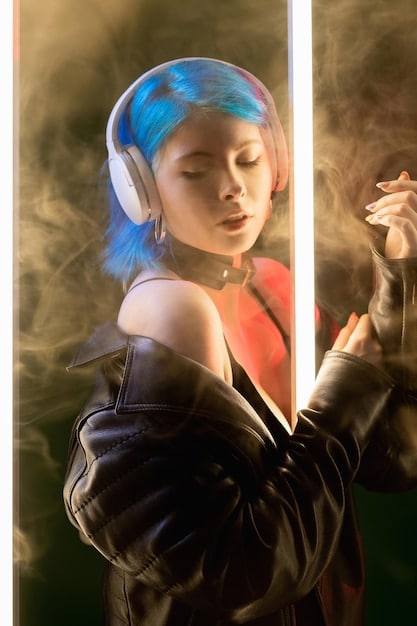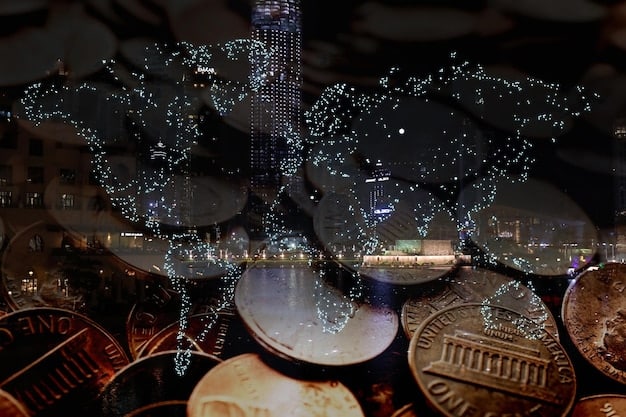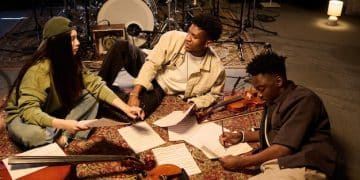How Emerging Artists Are Using NFTs to Fund Music Careers

Emerging artists are increasingly leveraging NFTs as a groundbreaking funding mechanism, offering direct revenue streams, fostering community engagement, and providing novel ways to monetize their creative works outside traditional industry gatekeepers.
In a rapidly evolving digital landscape, the music industry is undergoing a profound transformation. For emerging artists, securing funding and building a sustainable career has historically been a significant challenge. However, a revolutionary technology has emerged as a potential game-changer: Non-Fungible Tokens, or NFTs. This article explores How Emerging Artists Are Using NFTs to Fund Their Music Careers, offering new avenues for financial independence, direct fan engagement, and innovative artistic expression.
Understanding the NFT Revolution in Music
The advent of NFTs has fundamentally reshaped how digital assets are owned and exchanged. For musicians, this technology transcends traditional distribution models, offering a decentralized approach to intellectual property and monetization. It’s about more than just selling music; it’s about selling unique digital experiences and access.
At its core, an NFT is a unique digital asset, stored on a blockchain, that represents ownership of a specific item or piece of content. In the music realm, this could be anything from a song itself, an album, exclusive behind-the-scenes footage, concert tickets, or even unique digital merchandise. The beauty of NFTs lies in their verifiable scarcity and authenticity, addressing long-standing issues of piracy and fair compensation for artists.
What are Music NFTs?
Music NFTs are digital tokens that represent ownership or a stake in musical compositions, recordings, or related artistic content. Unlike traditional music files, which can be infinitely copied, an NFT makes a specific digital file unique and verifiable. This distinction is crucial for artists seeking to derive value from their creations in the digital sphere.
- Verifiable Ownership: NFTs provide irrefutable proof of ownership, recorded on a public blockchain, ensuring transparency and trust.
- Direct-to-Fan Connection: Artists can connect directly with their audience, cutting out intermediaries and fostering a more intimate relationship.
- Monetization Beyond Streams: While streaming platforms offer meager per-stream payouts, NFTs allow artists to set their own prices and distribute scarcity as they see fit.
- Royalty Mechanisms: Many NFT smart contracts can be programmed to include automated royalty payments back to the original artist on subsequent resales of the NFT.
The shift towards music NFTs represents a democratizing force, empowering artists to build their own economies and interact directly with their patrons. It fosters a new era of patronage, where fans invest in artists not just for their music, but for their journey and exclusive experiences.
Moreover, the transparency of blockchain technology ensures that every transaction is publicly recorded, providing a clear audit trail for both artists and collectors. This level of accountability is a stark contrast to the often opaque financial dealings of the traditional music industry.
As the ecosystem matures, we are seeing a diversification of NFT offerings within music. Artists are experimenting with different tiers of NFTs, from entry-level collectibles to high-value, limited-edition pieces that offer unique utility, such as exclusive access to future content or even a share in publishing royalties.
Building Community and Direct Fan Engagement
One of the most compelling aspects of NFTs for emerging artists is their capacity to cultivate deeply engaged communities. Traditional fan-artist relationships often involve layers of intermediaries, but NFTs dismantle these barriers, enabling direct interaction and a shared sense of ownership. This direct connection isn’t just about transactions; it’s about building a loyal tribe of supporters.
Through NFTs, artists can offer unique experiences and privileges that strengthen fan loyalty. This might include early access to new music, exclusive merchandise, virtual meet-and-greets, or even voting rights on creative decisions. Such engagement transforms passive listeners into active participants, fostering a sense of belonging and investment in the artist’s journey.
Exclusive Fan Experiences and Utility
Beyond simply owning a piece of art, NFT holders often gain access to exclusive benefits, known as “utility.” This utility is a key differentiator, turning a digital collectible into an interactive asset that deepens the fan experience. The more valuable the utility, the more attractive the NFT becomes to collectors.
- Access to Discord Channels: Private communities where fans can interact directly with the artist and other collectors, building a strong sense of camaraderie.
- Early Access to Music/Content: NFT holders might be the first to hear new tracks, view unreleased videos, or see behind-the-scenes footage.
- Voting Rights on Creative Projects: Allowing fans to influence creative decisions, such as tracklist order, album art, or even future song themes.
- Physical Merchandise and VIP Event Access: Bridging the digital and physical worlds, providing tangible rewards or exclusive entry to concerts and events.
The ability to offer tiered access through different NFT editions allows artists to cater to various levels of fan engagement, from casual supporters to super-fans. This granular control over fan benefits is a powerful tool for community building and long-term sustainability.
Artists are also using NFTs to create fan clubs and membership programs that transcend traditional models. Instead of a flat annual fee, an NFT provides a dynamic, tradable asset that represents membership, often accumulating value as the artist’s career grows. This turns fans from mere consumers into stakeholders.
Furthermore, the transparency of blockchain allows for verifiable claim of utility. Fans can trust that the exclusive benefits promised are genuinely delivered and that their ownership is secure. This transparency builds trust, which is foundational for any strong community.
Monetization Beyond Traditional Streaming
The traditional music industry model, heavily reliant on streaming royalties, has often left emerging artists struggling to make a living. Per-stream payouts are notoriously low, and the complex web of labels, publishers, and distributors can obscure financial transparency. NFTs offer a refreshing alternative, allowing artists to capture a larger share of the value they create.
By selling NFTs directly to fans, artists circumvent many of the intermediaries that typically take a large percentage of revenue. This direct-to-consumer model empowers artists to set their own prices, define the scarcity of their offerings, and retain greater control over their intellectual property and financial future.
Diversifying Revenue Streams with NFTs
NFTs are not just about selling songs; they open up a universe of creative monetization opportunities. Artists can tokenize various aspects of their creative process and output, transforming intangible artistic efforts into valuable digital assets.
- Single/Album Sales: Releasing an album or single as a limited edition NFT collection, where each NFT represents a unique copy or a part of the album.
- Collectibles and Art: Creating unique digital artwork, animated loops, or album cover art as NFTs, appealing to digital art collectors.
- Concert Tickets/Experiences: Selling tokenized access to live or virtual performances, often bundled with exclusive perks. These can also become tradable assets on secondary markets.
- Royalties on Secondary Sales: Programmable smart contracts allow artists to receive a percentage of every future sale of their NFT on secondary markets, creating a continuous passive income stream.
This ability to earn royalties on secondary sales is a particularly revolutionary aspect for artists. Unlike physical art or merchandise, where the artist typically receives no compensation for subsequent resales, NFTs ensure a lasting financial connection to their work. This perpetual income stream is a significant shift that can provide long-term financial stability.
Moreover, NFTs foster a culture of true patronage. Fans who purchase NFTs are not just buying music; they are investing in the artist’s career, becoming financial stakeholders in their success. This deepens the economic relationship and aligns incentives between artist and fan.
Artists are also experimenting with fractional ownership of master recordings or publishing rights through NFTs, allowing multiple fans to own a small stake in the underlying intellectual property. This model offers a novel way to raise capital for projects while decentralizing ownership and engaging fans in a deeper financial manner.

Navigating the Challenges and Risks
While NFTs present a groundbreaking opportunity for emerging artists, it’s crucial to approach this new frontier with a clear understanding of its inherent challenges and risks. The landscape is still nascent, rapidly evolving, and not without its potential pitfalls. Artists must perform due diligence and adopt a strategic approach to mitigate these issues.
One significant hurdle is the volatility of the crypto market. The value of NFTs can fluctuate wildly, impacting both the initial sale price and the potential for secondary market activity. Artists launching NFTs need to consider this instability and manage expectations, both for themselves and for their collectors.
Key Considerations for Artists
Entering the NFT space requires careful planning and a robust understanding of the underlying technology and market dynamics. Technical proficiency, market knowledge, and a strong community strategy are paramount for success.
- Market Volatility: The value of cryptocurrencies and NFTs can be highly volatile, impacting the financial returns for both artists and collectors.
- Gas Fees and Transaction Costs: Creating and selling NFTs involves “gas fees” on the blockchain, which can be significant and fluctuate based on network congestion.
- Environmental Concerns: The energy consumption associated with some blockchain networks (particularly Proof-of-Work) raises environmental concerns, though newer, more energy-efficient technologies are emerging.
- Security Risks: Artists and collectors must be vigilant against scams, phishing attempts, and wallet security breaches, as digital assets are vulnerable if not properly secured.
- Market Saturation and Discoverability: As more artists enter the NFT space, standing out and attracting collectors can become increasingly challenging, requiring strong marketing and community building.
Artists also need to consider the long-term implications of their NFT strategy. This includes the legal framework surrounding digital assets, intellectual property rights within the NFT context, and potential regulatory changes that could impact the market. Consulting with legal and financial experts familiar with the crypto space is advisable for substantial projects.
Another challenge lies in educating potential collectors. Many fans may not be familiar with cryptocurrencies or NFT platforms, requiring artists to simplify the onboarding process and provide clear instructions. This education component is vital for expanding the collector base beyond early adopters.
Despite the challenges, the rewards can be substantial for those who navigate the space wisely. The key lies in understanding the risks, building a strong community, and continuously adapting to the evolving NFT ecosystem.
Success Stories and Pioneering Artists
The journey of NFTs in music is still relatively young, yet it’s already filled with inspiring examples of artists who have harnessed this technology to revolutionize their careers. These pioneers range from independent artists to established acts, and their successes provide a blueprint for what’s possible in this new creative economy.
One notable early success was 3LAU, a DJ and producer who famously sold a collection of NFTs tied to his album “Ultraviolet” for over $11 million. This sale included redeemable experiences, unreleased music, and exclusive vinyl, demonstrating the power of utility-driven NFTs.
Examples of NFT Innovation in Music
Beyond individual sales, many artists are experimenting with innovative ways to use NFTs, pushing the boundaries of fan engagement and artistic monetization. Their approaches illustrate the diverse opportunities available.
- RAC: The Grammy-winning artist RAC launched a fan club called “RAC Pass” as an NFT, granting members early access to music, exclusive content, and voting rights for future projects. This transformed a traditional fan club into a dynamic, tradable asset.
- Grimes: The avant-garde musician Grimes sold a collection of digital art and short video clips as NFTs for millions of dollars, showcasing how musicians can merge visual and audio art forms in the NFT space.
- Kings of Leon: The rock band Kings of Leon released their album “When You See Yourself” as an NFT, offering three types of tokens: one for a special album package, another for live show perks, and a third for exclusive visual art. This marked a major step for a mainstream band embracing the technology.
- Imogen Heap: A forward-thinking artist, Imogen Heap has explored blockchain for fair music distribution and artist compensation, using NFTs as a mechanism for direct artist-to-fan sales and royalty distribution.
These artists aren’t just selling digital files; they’re selling access, community, and a stake in their creative journey. Their success underscores the potential for NFTs to empower artists by creating new value propositions for their work and fostering deeper connections with their fanbase.
The stories of these artists highlight the importance of creativity, not just in music, but in how NFTs are structured and deployed. The most successful projects often involve unique utility, strong community building, and a clear vision for how the NFT enhances the artistic experience.
Moreover, these trailblazers are setting precedents for legal and financial innovation within the blockchain space, paving the way for future artists to navigate this new landscape with greater clarity and confidence.
The Future Landscape: What’s Next for Music NFTs?
The trajectory of music NFTs is one of continuous growth and innovation. While still in its infancy, the technology is rapidly maturing, and its potential to reshape the music industry is immense. Looking ahead, several trends and developments suggest an even deeper integration of NFTs into the fabric of artistic creation and consumption.
We can anticipate a rise in more sophisticated NFT financial instruments, perhaps allowing artists to collateralize their future royalties or create decentralized autonomous organizations (DAOs) where fans directly govern parts of an artist’s career. The intersection of NFTs with other emerging technologies like the metaverse and artificial intelligence also promises exciting new frontiers for artistic expression and monetization.
Emerging Trends and Predictions
As the NFT ecosystem evolves, several key areas are poised for significant advancement, promising a richer and more integrated experience for both artists and fans.
- Interoperability: NFTs are likely to become more interoperable across different platforms and metaverses, allowing assets to be used and displayed in various virtual environments, increasing their perceived value and utility.
- Enhanced Fan Experiences: Expect more immersive and interactive NFT utilities, such as personalized virtual concerts, augmented reality experiences tied to music, and direct co-creation opportunities with artists.
- Mainstream Adoption: As the technology becomes more user-friendly and less intimidating, broader mainstream adoption by both artists and fans is inevitable, potentially leading to widespread use of NFT tickets, merchandise, and music ownership.
- Regulatory Clarity: Governments worldwide are beginning to grapple with how to regulate digital assets. Greater regulatory clarity will provide a more stable and predictable environment for artists and investors, reducing legal uncertainties.
- Sustainability Solutions: The industry is actively moving towards more eco-friendly blockchain solutions (e.g., Proof-of-Stake), addressing previous environmental concerns and making NFTs a more sustainable option for artists.
The concept of “music as an investment” will likely grow stronger, as fans not only collect art but also invest in the potential success of artists, fostering an even deeper symbiotic relationship. This shift could lead to new models of A&R (Artists and Repertoire) where community engagement and NFT sales serve as indicators of an artist’s potential.
Furthermore, expect to see more platforms emerge that simplify the NFT creation and distribution process, making it easier for artists without extensive technical knowledge to participate. This democratization of access will be crucial for wider adoption.
Ultimately, the future of music NFTs points towards a more equitable, transparent, and fan-centric industry, where artists have unprecedented control over their careers and creations. It’s a horizon filled with promise and endless possibilities for creative expression and financial liberation.

| Key Aspect | Brief Description |
|---|---|
| 💸 Direct Funding | NFTs enable artists to receive direct revenue from fans, bypassing traditional intermediaries and retaining a larger share of earnings. |
| 🤝 Community Building | NFTs foster strong fan communities through exclusive content, access, and shared ownership experiences. |
| 💡 Diverse Monetization | Artists can tokenize various creative outputs, from songs to digital art and experiences, creating multiple revenue streams. |
| 🚀 Future Potential | The NFT future promises enhanced interoperability, regulatory clarity, and sustainable blockchain solutions for artists. |
Frequently Asked Questions About Music NFTs
▼
A music NFT is a unique digital token representing ownership of a musical asset, such as a song, album, or exclusive content, secured on a blockchain. Unlike traditionally streamed music, an NFT provides verifiable authenticity and scarcity, allowing artists to directly monetize their work and connect with fans.
▼
NFTs help artists fund their careers by enabling direct sales to fans, bypassing traditional intermediaries. This allows artists to retain a larger share of revenue. Additionally, smart contracts can be programmed to pay artists royalties on secondary market sales, creating a continuous income stream, unlike traditional music sales.
▼
Almost any form of musical or related digital content can be sold as an NFT. This includes full songs, albums, exclusive demos, unreleased tracks, unique digital artworks, concert tickets, behind-the-scenes footage, and even fan experiences like virtual meet-and-greets. The creativity in what can be tokenized is expansive.
▼
Yes, there are risks involved. These include the volatility of cryptocurrency markets, which can affect NFT values, fluctuating “gas fees” for transactions, and potential security vulnerabilities if digital wallets are not properly secured. Artists also need to consider market saturation and the ongoing need for fan education and strong community building.
▼
NFTs foster fan engagement by offering exclusive utility beyond just owning a digital asset. This can include access to private Discord channels, early access to new music, voting rights on creative decisions, and VIP access to physical or virtual events. This direct interaction builds a stronger, more invested community around the artist.
Conclusion
The emergence of NFTs has unequivocally ushered in a new era for emerging artists, offering groundbreaking avenues for funding, creative control, and direct fan engagement. By democratizing access to capital and fostering genuine community, NFTs have begun to dismantle the traditional gatekeeping structures of the music industry. While challenges remain, the undeniable potential for artists to reclaim their autonomy and build sustainable careers in the digital age makes NFTs a transformative force. As the technology continues to evolve, its impact on how music is created, consumed, and valued will only deepen, ultimately empowering a new generation of creators.





